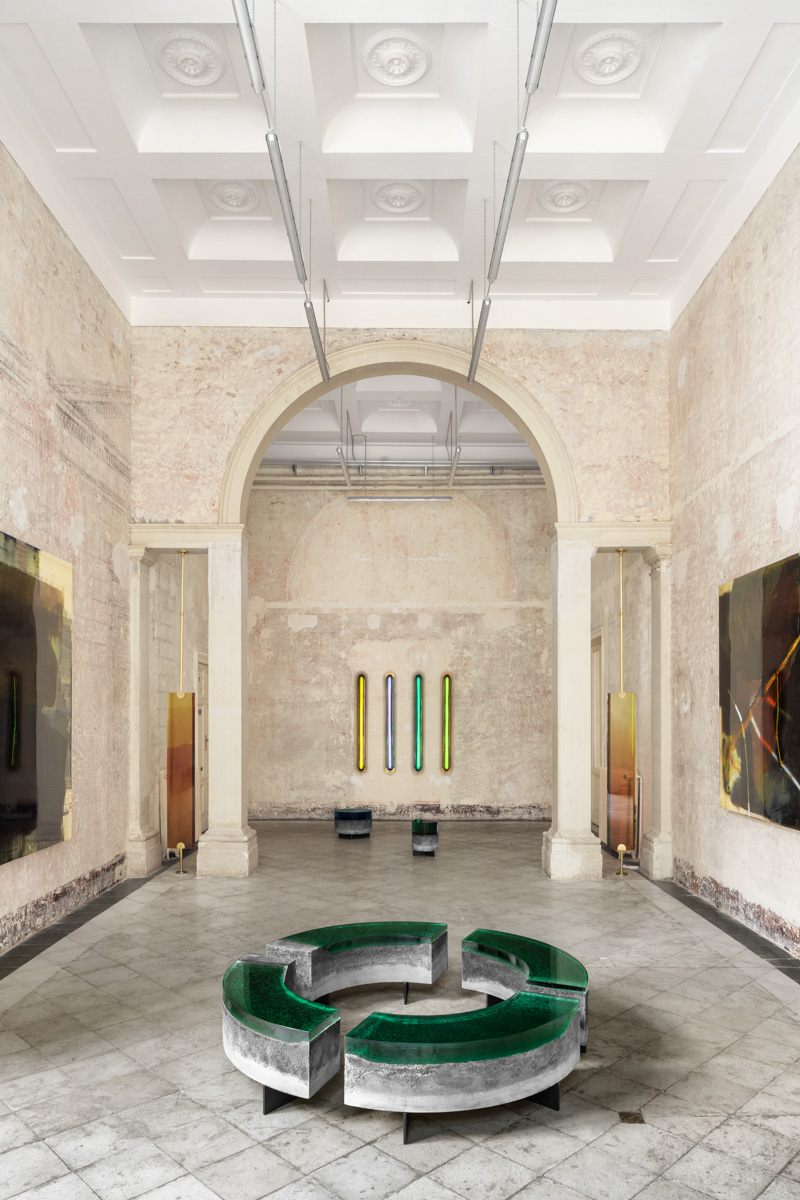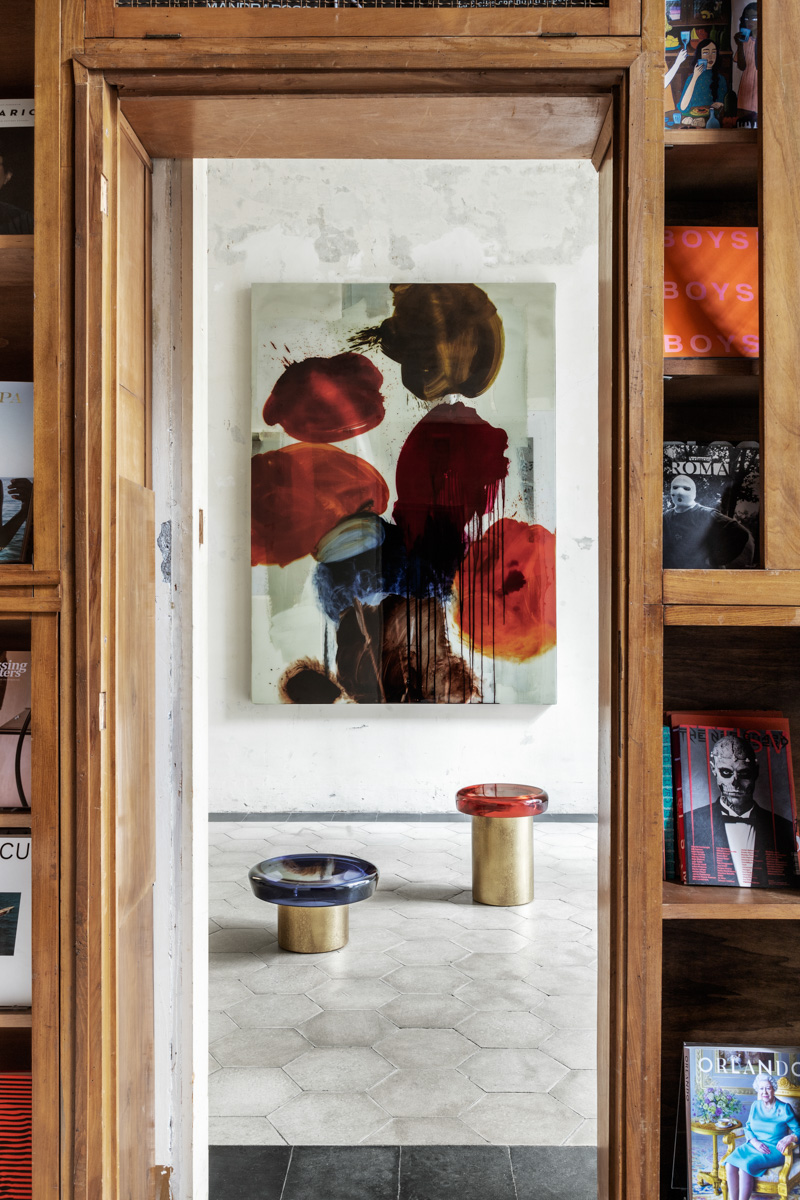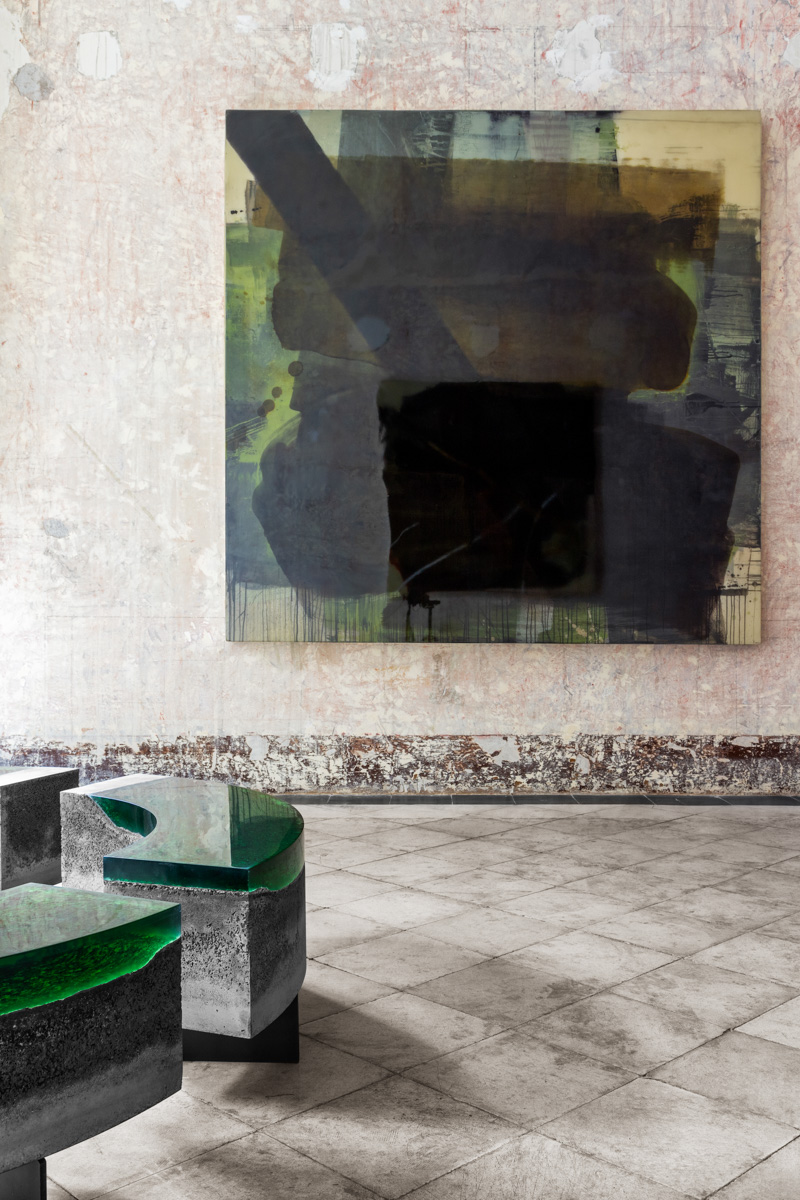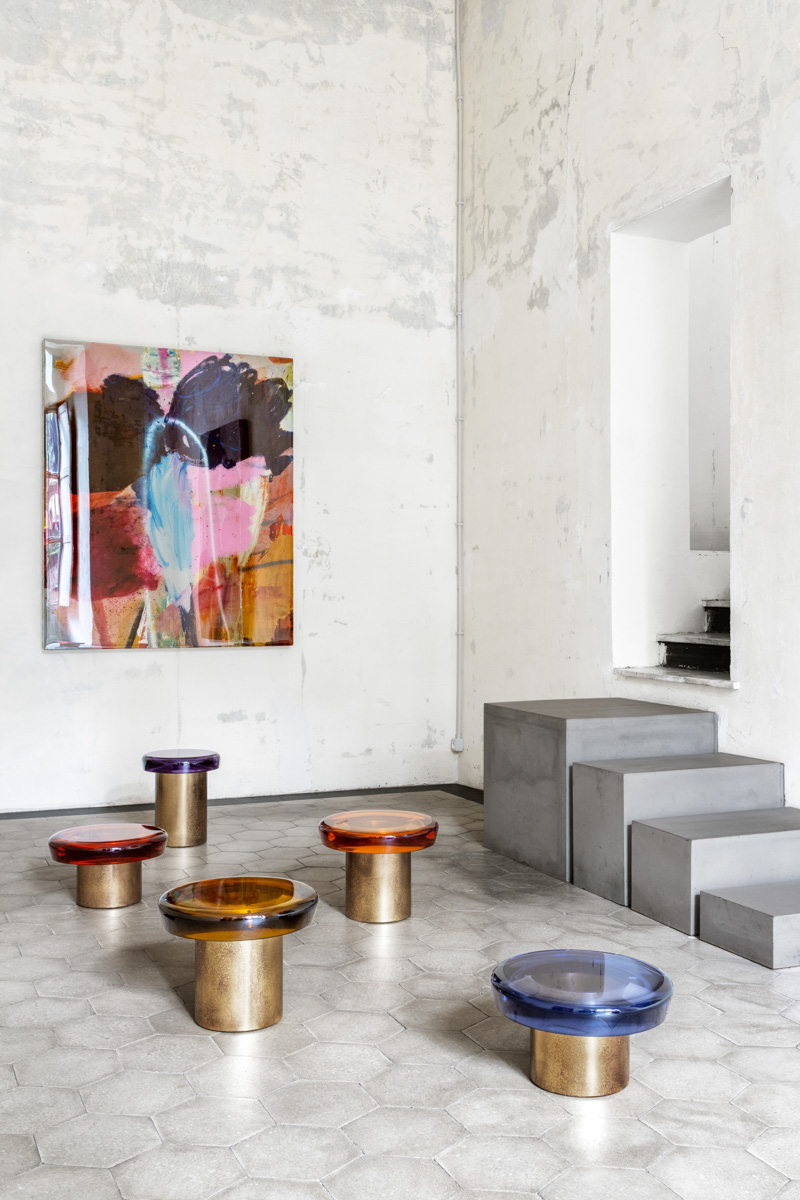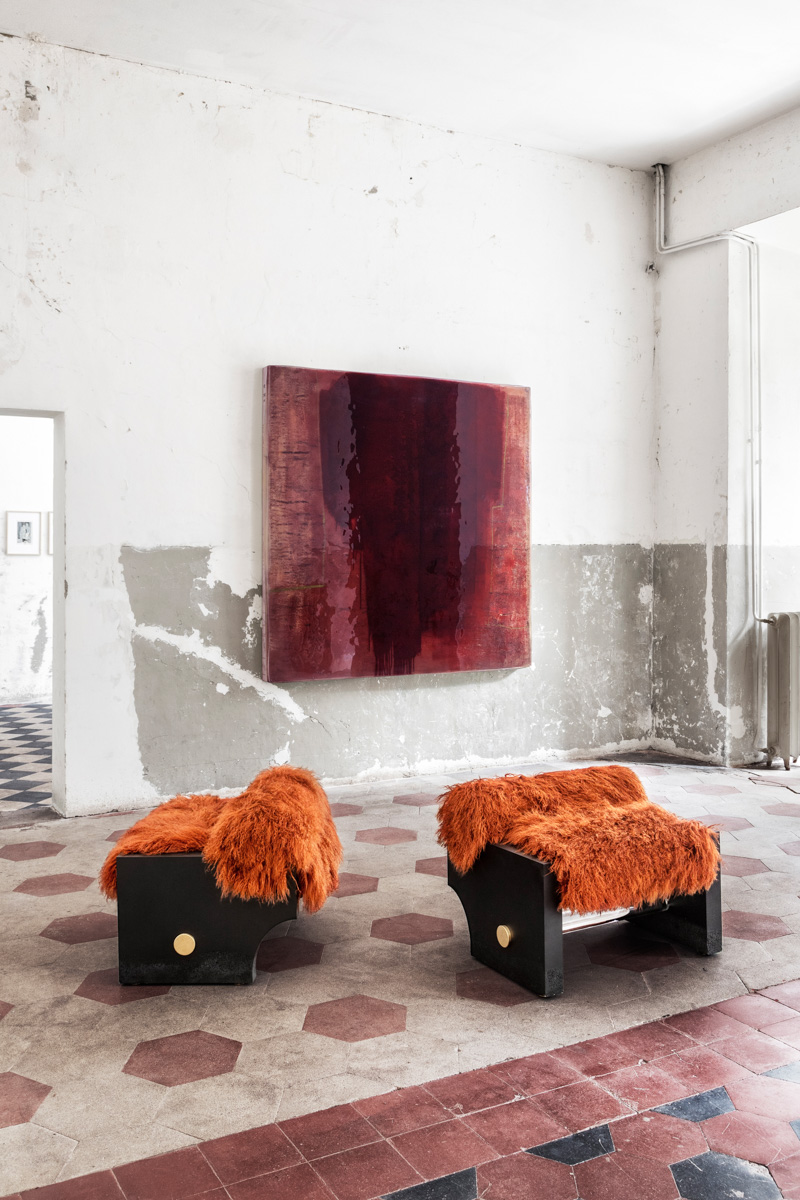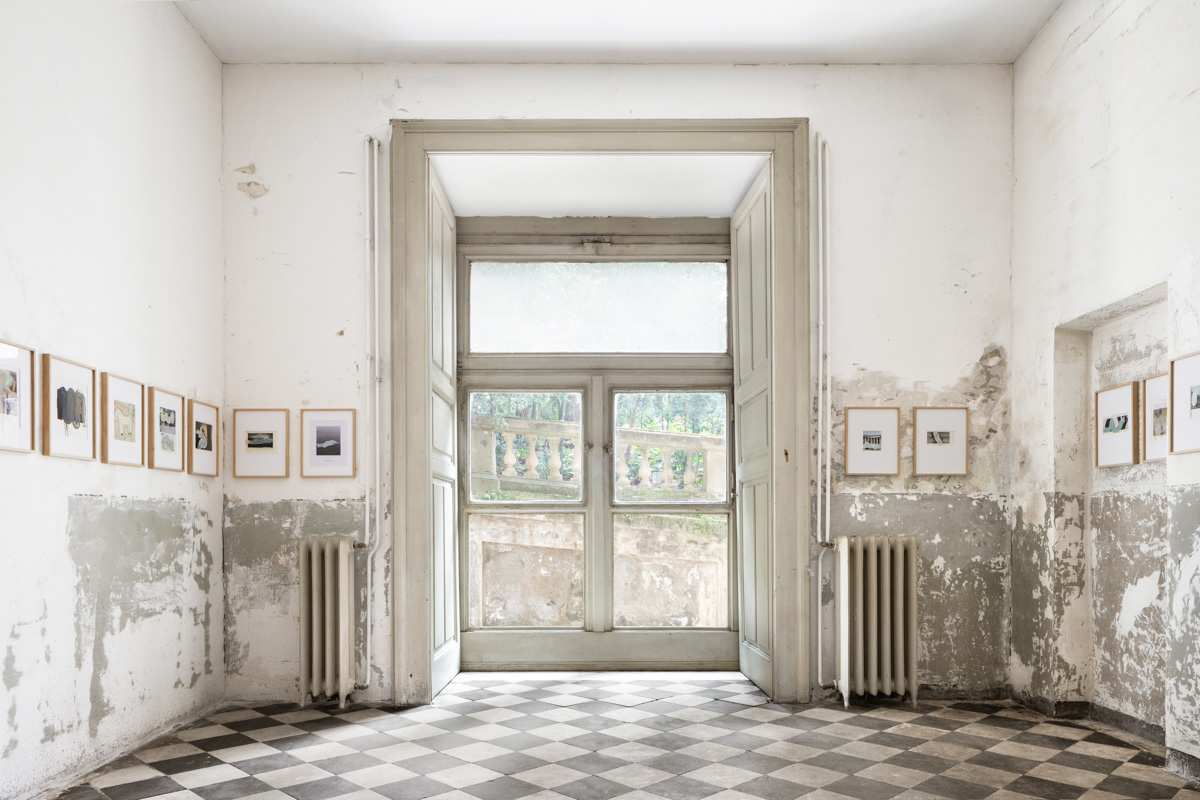Per Speculum in Aenigmate
Per Speculum in Aenigmate
Aurel & Draga
25th February - 13 March 2022
PALAZZO BRANCACCIO
c/o Contemporary Cluster
Rome
Critical text by Maria Chiara Valacchi
EN
The work of the duo Draga & Aurel is in a perennially split state — a scission in which its simultaneous nature as furnishing object and artwork is revealed. The ordinary use of each of their products is amplified in the infinite reflections cast by the resin surfaces, which, appearing as thick glassy petrifications with sidereal nuances, rest on slender iron or bronze structures or even incorporate cement concretions themselves.
Theirs is a consolidated formal and productive gestation, the aesthetic boundaries of which, however, Aurel recently decided to broaden, pushing beyond the paradigm of functionality, creating a series of works deprived of their strictest utilitarian task. These morph into veritable “canvases” resembling solid, translucent totems, sometimes containing fabric patterns and other times photographic images, often distended at the edges by the layering of paint and colored resins; a process that almost appears to be tied more to a very slow shamanic ritual than to the realm of painting.
Resting the bases on the floor, Aurel bends over them, instinctively applying color, creating flows, crosses, and spirals, before subsequently modifying and erasing them in part; these elements contribute to disturbing the features of the bodies portrayed in the photos or the underlying warps of the fabric. The initial model is gradually lost, drowned in a blanket of resin and other layers while the transparency of the extremely smoothed surface beckons us towards a discovery of its inner artificial sedimentation; as with much of their furniture, each user is faced with this knowing seamlessness between content and container.
For Contemporary Cluster in Rome, Draga and Aurel have conceived of a hybrid itinerary that thoroughly exhibits the results of their artistic production. With the same rhythm as a musical score – consisting of notes but also slurs, accents, and rests – they modulate intentionally “cathedral-like” environments, made up of the marked alternation of different elements: tubular lights, monochrome altarpieces or chairs, placed to emphasize spatial symmetry or disclose eclectic multicolored clusters, in which the large “canvases” described above create a counterpoint with a series of punctiform tables.
The last room only houses Aurel’s works. A moment of intimacy, a “rest”, in which he focuses on inner themes, closely related to the current pandemic status; concepts of fear or boredom are transferred and imprinted onto a set of papers, where watery, continuous, and very decisive magmatic brush strokes unhesitatingly camouflage the peculiar aspects of black-and-white photographs, all selected from the artist’s personal archive. The mysterious and inextinguishable concept of concealing can again be found in this array of little paper records, together with a new sense of fragility. The figures reproduced in each print, and their supporting material, lose their intrinsic value, becoming nothing more than a faint testimony to their initial pathos; the focus is inevitably shifted to the density of the gesture and to the temporal nature that accompanies the coating as it annihilates the image. Here, Aurel performs an additional act of denial, also freeing himself once and for all from the structural aspect of the work, the subject; a landing at “ground zero”, a place from which to rebegin to design tomorrow.
IT
L'opera del duo Draga e Aurel vive un perenne stato di sdoppiamento, una scissione nella quale si svela la sua simultanea natura di oggetto d’arredo e opera d’arte. La normale fruizione di ogni loro manufatto si amplifica negli infiniti riflessi prodotti dalle superfici in resina che, dall’aspetto di spesse pietrificazioni vitree e dalle nuances siderali, si poggiano su esili strutture ferrose o bronzee o ancora inglobano esse stesse concrezioni cementizie.
Una gestazione formale e produttiva consolidata la loro, alla quale però Aurel decide recentemente di allargare i confini estetici, di spingersi oltre il paradigma della funzionalità, creando un ciclo di lavori privati di quello che è il loro più stretto compito utilitaristico. Un morphing che si conclude in delle vere e proprie “tele” dalle fattezze di solidi totem traslucenti, contenenti ora trame di tessuti ora immagini fotografiche, dilatate spesso nei loro bordi grazie ad un lavoro di stratificazione di colore e resine colorate; un processo che più che legato alla sfera del dipingere, appare quasi un lentissimo rituale sciamanico.
Appoggiando la base sul pavimento, Aurel, si piega su di esse intervenendo in maniera istintiva con il colore, creando flussi, croci, spirali e successive parziali modifiche e cancellazioni delle stesse; elementi che contribuiscono a disturbare le fattezze dei corpi ritratti nelle foto o degli orditi sottostanti. Il modello iniziale si perde poco per volta, affogato nella coltre di resina e di altri layers, mentre l’estrema levigatura della superficie ci attrae nelle sue trasparenze, verso la scoperta delle sue sedimentazioni artificiali interne; come accade anche in molti dei loro fornitures, ogni fruitore si trova davanti a questa consapevole continuità tra contenuto e contenitore.
A Roma, per Cluster, Draga e Aurel pensano ad un percorso ibrido che mostri in maniera esaustiva i risultati della loro produzione artistica. Con la stessa ritmica di una partitura musicale – fatta di note ma anche di legature, accenti e pause – essi modulano ambienti volutamente “cattedralici”, composti dall’alternanza cadenzata di elementi differenti: luci tubiformi, pale monocrome o sedute, collocate per evidenziare simmetrie spaziali o dischiudere eclettici agglomerati policromi in cui le grandi “tele” – precedentemente descritte – entrano in contrappunto con una serie di tavoli puntiformi.
L’ultima stanza accoglie la sola opera di Aurel. Un momento intimo, una “pausa” nella quale egli si concentra su alcuni temi interiori, strettamente connessi all’attuale status pandemico; i concetti di paura o di noia si trasferiscono e imprimono in una serie di carte dove pennellate magmatiche – acquose, ininterrotte e molto decise – camuffano senza nessun tentennamento gli aspetti peculiari di immagini fotografiche in bianco e nero, tutte selezionate dall’archivio personale dell’artista. In questa carrellata di piccole testimonianze cartacee, si ritrova l’inestinguibile e misterioso concetto del celare, ma anche una nuova fragilità. I soggetti riprodotti in ogni stampa, e il loro materiale di supporto, perdono il loro valore intrinseco diventando solo una labile testimonianza del loro iniziale pathos; il focus si sposta inevitabilmente sulla densità del gesto e sulla temporalità che ne accompagna la stesura mentre annienta l’immagine. Aurel qui compie un ulteriore atto di negazione, si libera definitivamente anche dell'aspetto strutturale dell’opera, il soggetto; l’approdo ad un punto zero dal quale, domani, poter ricominciare nuovamente a progettare.
